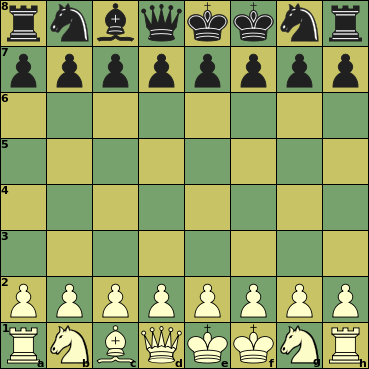Two Kings
 |
Initial setupe1, e8, f1, f8: King |
Moves at a Glance
Click on a piece below to see its moves
 |
 |
 |
 |
Sliding capture or non-capture, can be blocked on any square along the ray |
|||||||
 |
Unblockable leap (capture or non-capture) | ||||||||||
 |
Non-capture only | ||||||||||
 |
Capture only | ||||||||||
 |
 |
 |
 |
 |
 |
 |
|||||
 |
|||||||||||
:
:
:
:
| Piece | ID | value | Moves (Betza notation) | Remarks |
| King | K | - | K | Can castle with Rook, moving 2 steps towards it |
| Queen | Q | 9.5 | RB or Q | |
| Rook | R | 5 | R | |
| Bishop | B | 3.25 | B | Color-bound |
| Knight | N | 3.25 | N | |
| Pawn | P | 1 | mfWcfF | Promotes to Q, R, B, or N on reaching last rank |
Pawn peculiarities
- Pawns capture differently from how they move (straight move, diagonal capture).
- Pawns can move two squares straight ahead from their initial position, provided they are not blocked.
- On the move immediately after such a double push, they can be captured en passant by another Pawn, as if they had only moved 1 square ahead.
- Pawns promote to another (non-royal) piece of choice when they reach last rank.
Castling
An e-file King that has not moved before can move two squares in the direction of a Rook that has not moved before, in which case that Rook is moved to the square the King skipped over. This is only allowed if all squares between King and Rook are empty, when the King is not in check on the square it came from, and would not be in check on any of the squares it skipped over.
General rules
- The King closest to square a1 is the royal one (horizontal measure prevailing over vertical).
- It is not allowed to expose your royal King to capture ('check').
- The game is won by checkmating the opponent (i.e. being in check, and not being able to get out of it).
- Stalemate (no legal moves, but not in check) is a draw.
Differences with FIDE
You have a pair of Kings, and only a single Bishop. Only one of the Kings is royal, but which one can change during the game, as it depends on their relative location on the board.
Strategy issues
It is not possible to force checkmate on a bare King with just a single Bishop or Knight (in addition to your own King). Two Knights cannot do that either. Two Kings can force checkmate on a bare King.
Your non-royal King can be exposed to capture, and thus captured. After that, the remaining King will always be royal. Once both sides are down to a single King, this variant degenerate to orthodox Chess. The spare King is a tough defender, because it cannot be attacked by the opponent's royal King. So if all the attacker's power is in a single piece, the defending King pair has little to fear when they protect each other. This makes even KQKK is a draw (provided the Kings can connect).